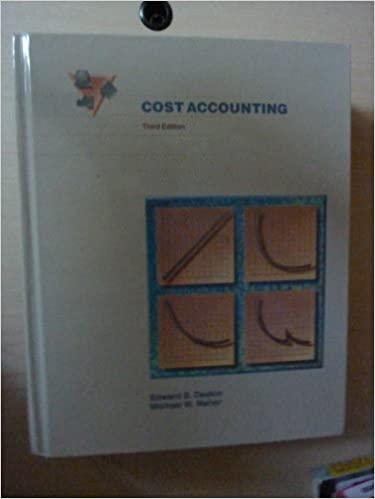Decentralization and Transfer Pricing: Calvin's Auto: Calvin's Auto was divided into three departments: new-car sales, used-car sales,
Question:
Decentralization and Transfer Pricing: Calvin's Auto: Calvin's Auto was divided into three departments: new-car sales, used-car sales, and the service department. Department managers were told to run their departments as if they were independent businesses. To give department managers an incentive. most of their remuneration was to be calculated as a straight percentage of their department's operating profit.. A customer wanted to trade in his old car as part of the purchase price of a new one with a list price of $16,000. Before closing the sale, the new-car manager had to decide on the amount he would offer the customer for the trade-in value of the old car. He knew that if no trade-in were involved, he would deduct about 10 percent from the list price of this model new car to be competitive with other dealers in the area. He also wanted to make sure that he did not lose the sale by offering too low a trade-in allowance. To establish the trade-in value of the car, the used-car manager accompanied the new-car manager and the customer out to the parking lot to examine the car. In the course of his appraisal, the used-car manager estimated that the car would require reconditioning work costing about $1,000, after which the car would retail for about $3.500. The used-car manager estimated that he could get about $2,100 for the car "as is" (that is, without any work being done to it) at a weekly auction at which dealers regularly buy and sell used cars.
The new-car department manager had the right to take any trade-in at any price he thought appropriate, but then it was his responsibility to dispose of the car. He had the alternative of either trying to persuade the used-car manager to take over the car and accepting the used-car manager's appraisal price, or he himself could sell the car at the auction.
The new-car manager decided he would allow $4,000 for the used car, provided the customer agreed to pay the list price of $16,000 for the new car. After some discussion, the $4,000 allowance and $16,000 list price were agreed upon. The company's accountant set about recording the sale in the accounting records of the business. She saw the new car had been purchased from the manufacturer for $13,000; she was uncertain about the value she should place on the trade-in car. The new car's list price was $16,000 and it had cost $13,000, so she reasoned the gross margin on the new-car sale was $3,000. Yet the new-car manager had allowed $4,000 for the old car, which needed $1,000 in repairs, after which it could be sold retail for $3,500. Uncertain about the value she should place on the used car for inventory valuation purposes, the accountant decided that she would temporarily put down a value of $4,000, and await instructions from her superiors. When the manager of the used-car department found out what the accountant had done, he went to the new-car deparment manager's office and stated forcefully that he would not accept $4,000 as the value of the used car. He stated:
1 never would have allowed the customer $4,000 for that car. My department has to make a profit too, you know. My own income is dependent on the profit I show on the sale of used cars, and 1 will not stand for having my income hurt because you are too generous.
The service manager arrived with Calvin Cline, the company president, and stated:
There is something bothering me about this accounting system we've been using. I can't charge as much on an internal job as I would for the same job performed for an outside customer. If I did work costing $1 ,000 for an outside customer, I would be able to charge about $1 ,600 for the job. I figure that I should be able to make the same charge for repairing a trade-in as I would get for an outside repair job.
Required:
a. Suppose the new-car deal is consummated, with the repaired used car being retailed for $3,500 and the variable cost of the repairs being $1,000. Assume that all sales personnel are on salary (no commissions), and that department and company costs not explicitly mentioned in the case are fixed and not affected by this transaction. What is the dealership contribution on the total transaction (that is, new and repaired used cars sold)?
b. Assume each department (new, used, service) is treated as a profit center, as described in the case.
(1) At what value should this trade-in (unrepaired) be transferred from the new- car department to the used-car department? Why?
(2) How much should the service department be able to charge the used-car department for the repairs on this trade-in car if the service department operates below capacity? Why?
(3) How much should the service department be able to charge if it operates at capacity? Why?
c. Given your responses to b., what will be each of the three departments' contributions on this transaction, assuming:
(1) The service department is operating below capacity.
(2) The service department is operating at capacity.
d. If the service department was operating at capacity, would the dealership be better off to repair and retail the used car or sell it "as is"?
e. Do you feel the three profit center approach is appropriate for the auto deal- ership? If so, explain why, including an explanation of how this is better than other specific alternatives. If not, propose a better alternative and explain why it is better than the three profit center approach and any other alternatives you have considered.
Step by Step Answer:






